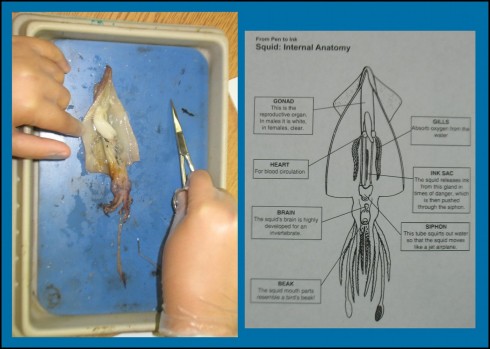
To follow up my own attempts at a fish anatomy lesson, I asked the people at the Gulf Coast Research Lab’s Marine Education Center to include a dissection in their program for our Adventure Trip. They chose squid.
Squid are nice because they’re mostly soft tissue and the organs are fairly easy to identify. They’re also quite charismatic, which piqued the students’ interest. These squid were going to be used as bait, so I didn’t feel too badly about using them for science.

Once again, our guide, Stephanie, was an excellent teacher. A good time was had by all, even though it was a bit gruesome.

I would have liked to have a little more time to draw some diagrams, but I don’t think my students would have had the patience. It was the Adventure Trip after all, and they’d much rather spend the time outside.
As for the future, I like this note about squid dissection:
… this … is a tactile experience. You may want to explore this aspect through sensory activities, written descriptions, poetry, and/or artwork. Encourage students to experience the many textures found inside and outside the squid’s body. Moving fingertips along the suckers is suggested as well – the suckers do not scrape or hurt if you are gentle with them.
–Center for Educational and Training Technology, Mississippi State University: Squid Dissection
This quote comes from a Mississippi State website, which also has a great set of calamari recipes in addition to dissection instructions. I’m always in favor of an interdisciplinary approach; food-preparation rather than purely dissection.
Finally, the University of Buffalo’s Biology 200 class has some excellent, labeled pictures, for reference.
